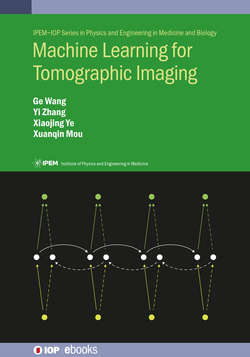Читать книгу Machine Learning for Tomographic Imaging - Professor Ge Wang - Страница 7
На сайте Литреса книга снята с продажи.
Foreword
ОглавлениеWe are currently witnessing a revolution in science and engineering: in only a few years, machine learning has become the basis for almost every single algorithm development. I still remember a college course on non-linear systems in the early 1990s: except for a few zealots, my peers and I used to think of neural networks as an exotic and entirely impractical field of science. Little did we realize how wrong we were. Increases in computing power, access to large amounts of data, and the creativity of many scientists have entirely changed that view. Today, neural networks have become more pervasive than the Fourier transform.
Some of the most popular applications of machine learning are in image analysis. You probably have some powerful deep learning networks in your pocket: just type ‘dog’ or ‘hat’ on your smart phone and it will instantaneously find all pictures containing your targets of interest. The application of machine learning may be less obvious in other areas, such as image generation. By now, machine learning has been at least considered for almost every imaginable algorithmic challenge. In the field of medical imaging, machine learning techniques can triage patients, determine the best scan parameters, perform image reconstruction, enhance images, analyze the quality of images, perform a diagnosis, compute a treatment plan, etc.
Dr Ge Wang was one of the earliest innovators who has been creatively exploring various ways of using deep learning in tomographic imaging since 2016, which is a long time ago given how fast the field has evolved. His team’s main impacts range across the topics of CT, MRI, and optical imaging, but they have also made fundamental contributions to the science of neural networks, such as through the investigation of quadratic deep neural networks.
Dr Wang teamed up with Dr Zhang, Dr Ye and Dr Mou to write this book on machine learning for tomographic imaging. The authors are uniquely qualified to undertake this major project, given their combined expertise in mathematics, computer science, image processing, and tomographic imaging, as well as their pioneering research in machine learning for medical imaging. At a high level, this book teaches medical imaging from the perspective of machine learning, and hence covers two important fields: machine learning and tomographic imaging.
The book’s first part gives a colorful and inspiring introduction to machine learning and tomographic imaging. Using the Human Vision System as reference, the authors take us on a journey from sparse representations, through dictionary learning, to neural networks and deep learning. Many ‘textbook’ deep learning architectures are covered at an introductory level. Parts two and three provide an in-depth tutorial of CT and MR image reconstruction, followed by a wide range of machine learning techniques that were developed in recent years. The fourth part further enriches the content of this book by elaborating on other imaging modalities, image quality evaluation, and quantum computing.
Overall, this book provides an amazingly comprehensive overview of neural networks and tomographic reconstruction methods. It is written in an engaging and accessible style, without lengthy mathematical derivations and proofs. This makes it ideal for introducing machine learning and tomographic imaging in the more applied disciplines (physics and engineering), and also for bringing application contexts into the more theoretical disciplines (mathematics and computer sciences).
Every medical imaging scientist who graduated before machine learning was taught in college should probably learn about this area in order to remain competitive. To my knowledge, this book is the first and only publication capturing all important aspects of machine learning and tomographic imaging in one place.
I highly recommend this book for any medical imaging students/professionals with a STEM background. Start with chapters 1–3. Then, depending on whether you are a CT, PET, MRI, ultrasound, or optical imaging aficionado, you may select one or more of the other chapters for further study. Before you know it, you will ‘deeply learn’ this exciting new science, be able to talk intelligently about it, and perform state-of-the-art research in a world that can no longer be imagined without neural networks.
Bruno De Man, October 2019
